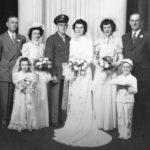We'd love to have you access this content. It's in our members-only area, but you're in luck: becoming a member is easy and it's free.
Already a Member?
Not a Member Yet?
My suitcase was packed and ready for our trip to Syracuse, NY, the day after the wedding ceremony because Albert would have to report to base Monday night. That trip would be the only honeymoon we would have because we were having a World War 2 wedding!
We Prepare for Our World War 2 Wedding
On Saturday evening, Mr. and Mrs. Ledoux threw us a pre-nuptial party at their home. I had known them for a long time already so they were not strangers to me. Our friends and relatives dropped by to wish us well. Mrs. Ledoux had prepared finger foods and served soft drinks and beer. I supposed Rhéa [Lavigne, Albert’s sister] had helped her.
Sunday called for all the food to be ready as well as for my suitcase to be packed and ready for our trip to Syracuse, NY, the next day after the wedding ceremony because Albert would have to report to base Monday night. That trip would be the only honeymoon we would have because we were having a World War 2 wedding! [Free Membership required to read more. See below. ]
This post is one of over 500 informative, well-written articles we have made available to you on this site.
We’ve contributed to your writing success; now we ask you to contribute to the expansion of the memoir conversation.
By reposting this article on your blog or website or reposting on your favorite social media, you will inform your fellow memoir writers of the programs and services—many for free like the blogs—that are available at TheMemoirNetwork.com.
Thanks for your generosity. You rock.


No comments yet.